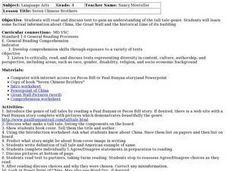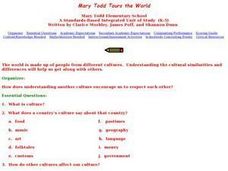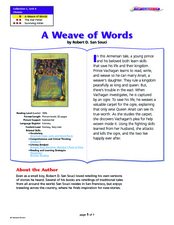Curated OER
Wappo Indians of Napa County
Third graders describe the American Indian nation in their local region long ago and in the recent past in terms of national identities, religious beliefs, customs, and various folklore traditions. They synthesize their findings into a...
Curated OER
Dominant Impression
Students explore author's purpose, are introduced to dominant impression, make a list of descriptive words or phrases and write from personal experience.
Curated OER
Dominant Impression: Writer's Workshop Mini Lesson Based on the book: The Empty Pot by Demi
Students investigate folk and fairy tales. For this reading comprehension lesson, students review the concept of author's purpose after listening to "The Empty Pot" by Demi. Students also explore descriptive words and dominant impression...
Curated OER
A Walk in the Woods: The Legacy of the Haudenosaunee
Fourth graders explore folktales and legends to investigate the life and culture of the Haudenosaunee Indians. The stories and food of the six Nations are experienced as the lesson proceeds.
Curated OER
Living History - Civil War
Eighth graders, after researching antebellum North Carolina and the role of North Carolina in the Civil War, write, edit, publish, and produce their own plays.
Curated OER
Murals, Memories, and Making Art
Fourth grade reading students study art works by famous artists. They use various tools for learning about the artist, and they present their information by writing and speaking about the artist. They also create artwork in the style of...
Curated OER
Contemporary Fairy Tales
Eighth graders listen Steven Kellog's, Jack and the Beanstalk, and Raymond Briggs, Jim and the Beanstalk. They use a Venn diagram to compare the two elements of the two stories. They write and publish an original contemporary fairy tale...
Curated OER
Hank Williams: My Inspiration
Students research information about Hank Williams using the internet. Using the lyrics from his songs, they interpret the poetry used. They work together and individually to write their own poems and interpret them.
Curated OER
Arkansas Black Pioneers: A History of African-American Colonies in Arkansas
Students research regions of early Arkansas as they relate to African American colonies in Arkansas after the Civil War. They discuss the characteristics of the regions, view a Powerpoint presentation, and write reflective journals.
Curated OER
Symbolism: Finding the Hidden Meaning In Chinese Art
Pupils study and interpret Chinese art to find its symbolism, or the "hidden meanings" in this middle level lesson well suited for the Language Arts or Art classroom. An enrichment activity is included that allows each student to write...
Curated OER
Native American Boarding School Encounters in Washington State: School Communities Over Time in the Pacific Northwest
Students are introduced to the various types of schools used throughout history. In groups, they compare and contrast Native American boarding schools, schools in the 1800s and the schools of today. They write in their journals...
Curated OER
Hajigul's Story: A Creative Drama
Students listen to stories about and research the life of an Uighur child from China. They investigate their own cultural heritage and design a mural.
Curated OER
Literacy Lesson: Guided Reading
Here is a wonderful instructional activity designed for students with special needs. This well-thought-out instructional activity uses Big Books, familiar stories, and has a lot of review learning built into it. The book, The Keeping...
Curated OER
Sequencing a Chinese Folktale
Students sequence the events of the popular Chinese folktale "The Terrible Nung Gwama" using a graphic organizer. This lesson takes 45-minutes and includes two possible enrichment activities.
Curated OER
Seven Chinese Brothers
Fourth graders identify the characteristics of a tall tale. They read "The Seven Chinese Brothers" and analyze it for these characteristics. Students complete a comprehension worksheet and discuss why "The Seven Chinese Brothers" can be...
Curated OER
Westward Expansion
Students examine how the events that took place during the time of the Westward Expansion affected the pioneers and Native Americans through the seven lessons of this unit. Enhancements in transportation over time are also a part of the...
Curated OER
Congressional Scenarios
In this U.S. government worksheet, students read 12 scenarios pertaining to government intervention and determine what to do as lawmakers in response to each of the scenarios.
Curated OER
China: Land Beyond the Wall
An excellent series of five lessons on China awaits you and your young geographers. In these lessons, learners engage in hands-on activities, watch streamed video, access websites, and complete activities in cooperative groups in order...
Curated OER
Exploring Animals in Literature
Celebrate Be Kind to Animals Week while teaching empathy and allegory with creature-related texts
Curated OER
The Meaning of Christmas Told through a Mexican Folktale
Using a Tomie dePaola story, The Legend of the Poinsettia, your class can explore the meaning of Christmas.
Curated OER
Traditions and Languages of Three Native Cultures: Tlingit, Lakota, and Cherokee
Young scholars explore the connections between tradition and language. They examine the environment, history and culture of the Tlingit, Lakota and Cherokee tribes and identify the importance of maintaining languages for oral traditions.
Curated OER
Mary Todd Tours the World
Pupils analyze how distinguishing another culture encourages us to respect each other. They research culture and all its avenues, recognizing and comprehending the relationship between people and geography. Ultimately, they can apply...
Curated OER
A Weave of Woods
Focus on vocabulary, comprehension, and analysis while reading A Weave of Woods, a colorful picture book by Robert D. San Souci. Young learners use worksheets to preview, predict, practice paraphrasing, and make comparisons. The richly...
Curated OER
Juan Verdades
Cement comprehension skills using the strategies in this activity. After reading the story, Juan Verdades by Joe Hays, learners use context clues to answer questions, identify main ideas and details, and sequence events.

























